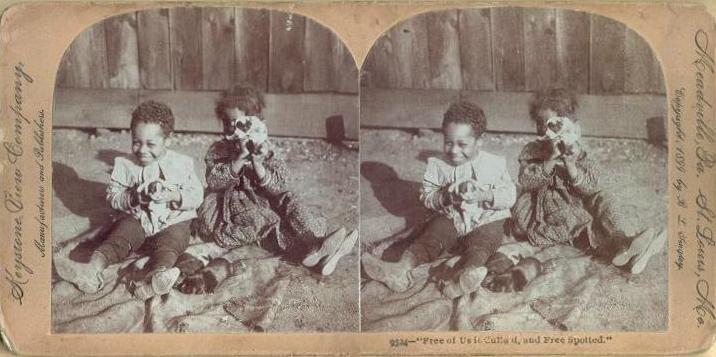
Freed Blacks in America (1860s-1940s)

Figure 1.--Many but not all commercial images of blacks were overtly racists in the late-19th and early-20 century. Here we see a stereoscopic view of two black children with puppies. This is a vintage Keystone Stereoview, dated 1899. They were probably children of freed slaves. We do not understand the caption. It read, "9524--"Free of Us if Cullu d and Free Spotted." As the company was located in St. Louis Missouri, presumably the children were from St. Louis.
|
|
There are relatively few photographic images of actual slaves before the Civil War (1861-65). And even viewer that were more tan studio portraits providing insights om life style. Daguerotypes were relatively expensive. Slaves and even most free blacks could not afford them. And few slave owners were iterested in photographing their slves. The new CDV and cabinets cards were much less expensive, but only became available in the 1860s as the slaves were being liberated by Federal soldiers during the Civil War. Thus we have many more images of blacks in America after emancipation. These images provide fascinating insights into life for blacks in the period from Emancipation (1863-65) to the beginning of the Civil Rights Movement after World War II (1941-45). Many but not all of these images are raciss, especially the commercial images. But blacks as other Americans had their portraits taken and afer the turn-of-the 20th century, family snap shots become available. During this period we see many of the same social patterns persisting even after Emancipation. Share cropers were still dirt poor--although the end od slavery should not be seen as unimportant. Blacks continued to live mostly in the South until the advent of the 20th century. We note emmigration north, especially after World War I. There is the gradual growth of a black middle class. Black communities often centered on the Church. Blacks in many ways lived a separate existince in America, especially in the North. There were social interactions that in some way were more intimate than is the case in modern America. This was especially true in the South. The segregated housing patterns in many southern cities, for example, are relatively recent phemomena.
CIH

Navigate the Children in History Website :
[Return to the Main free blacks in America page]
[Return to the Main race page]
[About Us]
[Introduction]
[Biographies]
[Chronology]
[Climatology]
[Clothing]
[Disease and Health]
[Economics]
[Freedom]
[Geography]
[History]
[Human Nature]
[Ideology]
[Law]
[Nationalism]
[Presidents]
[Religion]
[Royalty]
[Science]
[Social Class]
[Bibliographies]
[Contributions]
[FAQs]
[Glossaries]
[Images]
[Links]
[Registration]
[Tools]
[Children in History Home]
Created: 6:05 PM 1/3/2009
Last updated: 6:05 PM 1/3/2009



